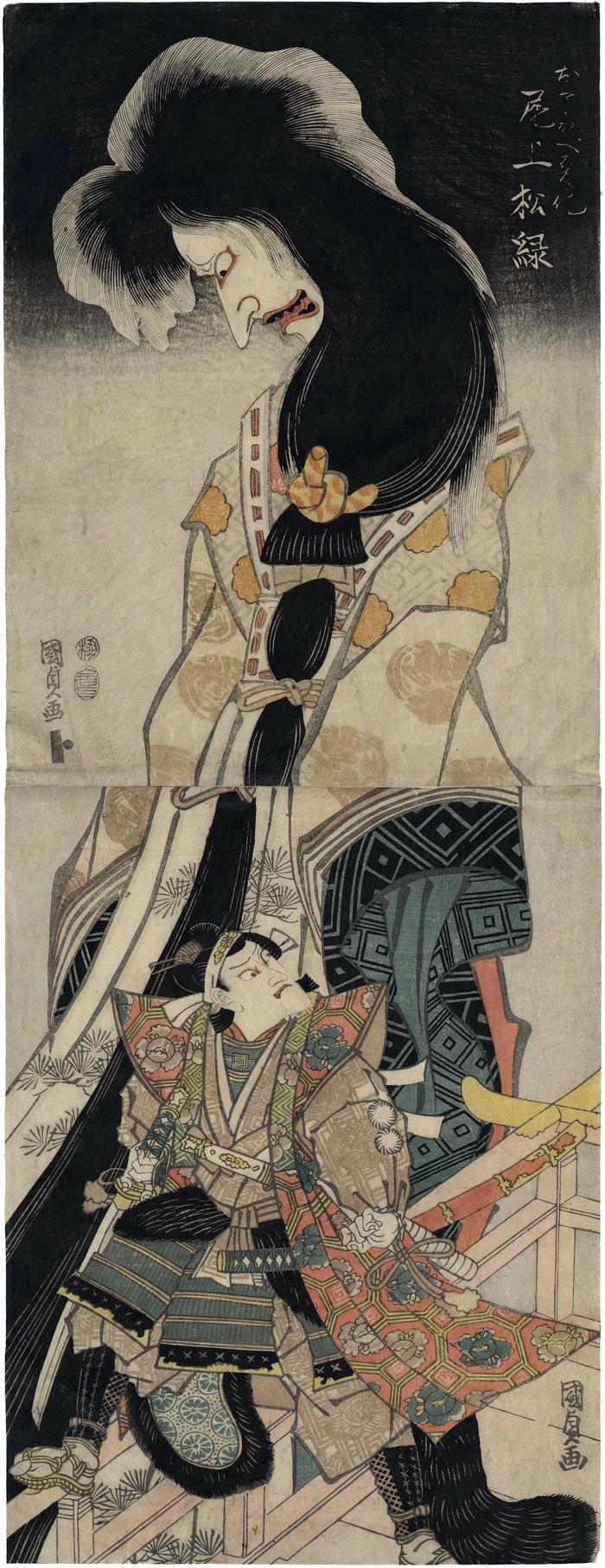Utagawa Kunisada (歌川国貞) / Toyokuni III (三代豊国) (artist 1786 – 01/12/1865)
Onoe Shōroku I (尾上松緑) and Ichikawa Danjūrō VII in a scene from Shōroku's revival of the story of Princess Osakabe (Matazoro Shōroko Osakabe banashi)
1814
9.675 in x 25.125 in (Overall dimensions) Japanese woodblock print
Signature: Kunisada ga
Publisher Yamaguchiya Tōbei (Marks 591 - seal 15-005)
Censor seals: Iwato and kiwame
Ritsumeikan
Royal Museums of Art and History, Belgium (via Cultural Japan)
Lyon Collection - another copy of the top panel In this writer's opinion, this vertical diptych is one of the greatest compositions in the entire world of ukiyo-e prints. Out of thousands, even hundreds of thousands compositions, this one stands out among the most select images ever.
Clearly the dominating feature of this diptych is that of the figure of Onoe Shōroku I. However, Ichikawa Danjūrō VII was also a giant of the theatrical stage in his own right. If you click on the picture and enlarge it you will notice that Danjūrō VII is wearing a costume decorated liberally with both of this actor's clan crests, the peony and the mimasu which is composed of three nested rice measures. Another print from 1820 in the Lyon Collection by Kunisada, #393, shows Danjūrō VIII wearing an outfit with the pants displaying the same two crests.
****
Sixteen feet tall
Sebastian Izzard gave a cogent summary of this diptych in Utagawa Kunisada: His World Revisited in 2021 on page 54 and illustrated on page 55:
"Onoe Shōroku (1744-1815) was famous as a performer of female ghosts. In this spectacular scene, he appears as the sixteen-foot-high apparition of Princess Osakabe, haunting Hayakawa Takakage, played by Ichikawa Danjūrō VII, on the battlements of Himeji castle."
"Tsuruya Nanboku IV was the first to realize the potential of playing ghost plays in the summer. those months had formerly been a slack time for theaters when star players took vacations. In the early nineteenth century, by adding magic and ghost spectacles, theaters found that they could capture new audiences and give them a satisfying chill during the sweltering summer heat."
One child was so frightened that he tried to get away, but the crowd of theatergoers was so dense that escape was impossible.
"The Osakabe role required a great deal of strenuous physical action to manipulate the costume, and according to the Kabuki scholar Ihara Toshirō, the seventy-year-old Shōroku was criticized for taking it on when he was well passed his prime. He died the following year. Kunisada recognized Shōroku's achievement by only naming him in this portrait, although the young Danjūrō VII bravely confronting the demon in the foreground can be easily identified by his large eyes, the peony (one of the actor's personal emblems), and the interlocked mimasu pattern of his under-robe."
The Ichimura-za, where this was staged, was so strapped financially after the rising costs of actors' salaries and the expenses of producing such a fantastical performance, that it went bankrupt the next year and did not reopen until the early 1820s.
****
Illustrated:
1) in black and white in Kunisada's World by Sebastian Izzard, Japan Society, Inc., 1993, no. 1, page 42. This example is from the Musées Royaux d'Art et d'Histoire, Brussels.
2) in color in Utagawa Kunisada: His World Revisited by Sebastian Izzard, Sebastian Izzard, LLC, 2021, no. 5, page 55.
3) in color in Kunisada: Imaging Drama and Beauty by Robert Schaap, Hotei Publishing, 2016, p. 75. This example is the same one from the Musées Royaux d'Art et d'Histoire, Brussels.
Yamaguchiya Tōbei (山口屋藤兵衛) (publisher)
Onoe Shōroku I (初代尾上松緑: 11/1809 to 10/1815) (actor)
Ichikawa Ebizō V (五代目市川海老蔵: 11/1797 to 10/1800 and 3/1832 to 3/1859) (actor)
Yūrei-zu (幽霊図 - ghosts demons monsters and spirits) (genre)
Kakemono-e - 掛物絵 (genre)
Ichikawa Danjūrō VII (七代目市川團十郎: 11/1800 to 2/1832) (actor)
